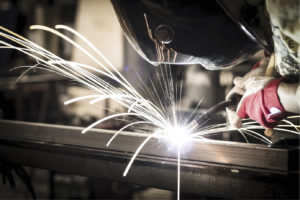Protecting Workers from Welding Hazards

Exposure to welding fumes and gases may be acute or prolonged. Acute exposure can cause eye, nose and throat irritation, dizziness and nausea. (photo courtesy Adobe Stock)
By: Barbara Nessinger, Editor-in-Chief
According to the American Welding Society, an estimated 50% U.S. gross national product is affected by welding. Anything made of metal, no matter how big or small, can be welded. Welding is the most common method used to join metal parts in large structures and equipment, due to its strength. Soldering and brazing are similar processes to welding, but they are used on electronic and other small equipment and use lower temperatures to melt the filler metal.
Most welding today falls into one of two categories: arc welding (the use of an electrical arc to melt the work materials) and torch welding (the use of an oxyacetylene torch to melt the working material and welding rod). There are more than 100 welding processes; most involve a skilled worker using a high-heat torch; filler material that is usually in wire or stick form; and pressure to permanently bond metal pieces.
Welding, cutting, brazing and grinding all create significant fire and explosion risks. This type of work generates hot sparks and slag. Those can then come into contact with nearby combustibles and flammable gases.
Most welding safety practices and equipment are universally applicable. Welding exposes everyone to similar hazards, from a welding-intensive manufacturing company; a billion-dollar engineering and construction firm; a small independent fabricator; or someone responsible for safety-at-large in the workplace. Wearing the proper PPE equipment is extremely important to keep welders and watchers safe from multiple hazards.
Implementing good welding/hot-work safety practices can help do more than just save lives. When welding safety becomes an ingrained part of the corporate culture, there can be fewer reduced lost-time incidences and improved productivity. [See sidebar “Preventing Hot-Work Accidents.”]
Energy is Everything
Clothed in protective gear, surrounded by flying sparks, the welder wields a powerful energy source and generates heat up to 15,000°F in order to fuse two materials together into a strong joint—called a weldment—that will be permanent once the parts cool. An economical and efficient process, welding is vital to the construction, manufacturing, aerospace, automotive, railroad and shipping industries, among others.
Many of the potential dangers of using the kinds of energy sources (electric arc, gas flame, laser, electron beam, friction or ultrasound) and extreme heat required in welding are obvious and straightforward: burns, electric shock, vision damage and exposure to ultraviolet radiation at unhealthy levels. Another risk, arising from the inhalation of hazardous fumes and gases, is more complex, in that both the types of toxins and the range of potential health effects are many.
Fumes, Explained
Welding fumes are condensed into very fine particles when a metal is heated above its boiling point; they are a mixture of metallic oxides, silicates and fluorides, as well as particles from the electrode and the material being welded. Both the metals being welded and the coatings or residue on those metals can contribute toxins to welding fumes. Among the metals and gases that welding fumes can contain include aluminum, antimony, arsenic, beryllium, cadmium, chromium, cobalt, copper, iron, lead, manganese, molybdenum, nickel, silver, tin, titanium, vanadium, zinc, argon, helium, nitrogen, carbon dioxide, nitric oxide, nitrogen dioxide, ozone, phosgene, hydrogen and fluoride.
The composition of fumes depends on the materials being welded. Steel welding, for instance, produces fumes that mostly contain iron, along with small amounts of chromium, nickel, manganese, molybdenum, vanadium, titanium, cobalt and copper. Fumes arising from stainless steel welds have a large amount of chromium or nickel and a small amount of iron.
Longer Exposures = Serious Health Problems
Exposure to welding fumes and gases may be acute or prolonged. Acute exposure can cause eye, nose and throat irritation, dizziness and nausea. (Workers who experience these symptoms should leave the area immediately and obtain medical attention.)
Prolonged exposure may cause lung damage; lung, larynx and urinary tract cancers; stomach ulcers, kidney damage and nervous system damage. The list, below, contains just some of the hazardous materials found in welding and the potential health effects that acute or prolonged exposure to them can cause.
- Zinc oxide g Metal fume fever
- Manganese fume g Parkinson’s–like symptoms
- Helium, argon & carbon dioxide g Suffocation
- Carbon monoxide g Asphyxiation
- Hexavalent chromium g Damage to eyes, skin, nose, throat & lungs; cancer
- Ozone g Headaches, dry eyes, lung damage
- Copper g Nausea, irritation of eyes, nose & throat, metal fume fever
Factors that can affect worker exposure to welding fumes include the type of welding process used; the kind of base and filler metals used; the composition of the welding rod; the welder’s work practices; the location in which the welding is done (outside or in an enclosed space); the air movement in that location; and the use of ventilation controls.
In addition to the energy sources mentioned above, a laser, an electron beam, friction and ultrasound are also used in welding.
Reduce Worker Exposure
Proper ventilation is important to reducing fume and gas levels in a workspace. Welding should not be done in confined spaces that lack sufficient ventilation. Even in outdoor or open workspaces, care should be taken to ensure adequate ventilation. For instance, when welding outdoors, workers should position themselves both upwind—in order to avoid breathing welding fumes and gases—and from other workers. In other scenarios, local exhaust ventilation systems can help remove toxic gases from the welder’s breathing zone.1
1 osha.gov/Publications/OSHA_FS-3647_Welding.pdf
Preventing Hot-Work Accidents
According to OSHA, between 2005-2015, there were 85 fire-related deaths in the oil and gas industry. Of those, 28 occurred due to improper hot-work practices. RMI’s blog, titled “Preventing fires with a Hot-Works Program,” provides some general guidance on ways to prevent hot-work incidents, even for those not working in oil/gas. Here are some basic ways to prevent hot-work incidents:
Having and using a hot-work permit
A written permit is required in certain situations, but it’s a good idea to use them for all your hot-work activities. The permit ensures that all necessary safety precautions are in place. It also helps lower the risk of fire or explosion.
Performing hot-work in a safe location
Remove all combustibles from the area before conducting hot-work. Whenever possible, perform the work in an area that won’t interfere with other workers.
Wearing the proper PPE
Always wear FR clothing when performing hot work. It is the responsibility of the employer to provide this to the employee. Further, FR clothing should be maintained and kept in good condition.
Using fire blankets to protect equipment from sparks and slag
If you cannot move combustibles or nearby equipment out of the way, lay fire blankets over them. This will protect them and prevent them from catching fire.
Having fire extinguishers nearby and ready
Employees should always know where to find the nearest fire extinguisher. This is even more critical when performing hot-work. Hoses and other suppression equipment can work, too.
Assigning a fire watch for all hot-work activities
A fire watch should always be present for hot-work activities. The fire watch should know how to sound the alarm in the event of a fire. They should also know to only extinguish a fire when it is small and contained to one area. OSHA requires the fire watch remain in place for at least 30 minutes after the work is complete.
[For the complete blog, go to: http://blog.rmiwyoming.com/fire-prevention-for-the-oil-and-gas-industry.]
Share on Socials!
Respiratory Protection: OSHA’s 1910.134
Aerosol Science Significance for COVID
Breathe Easy: A 10-Step Respiratory Protection Training Plan
Leaders in Industrial Hygiene
Council for Accreditation in Occupational Hearing Conservation (CAOHC)
Subscribe!
Sign up to receive our industry publications for FREE!









